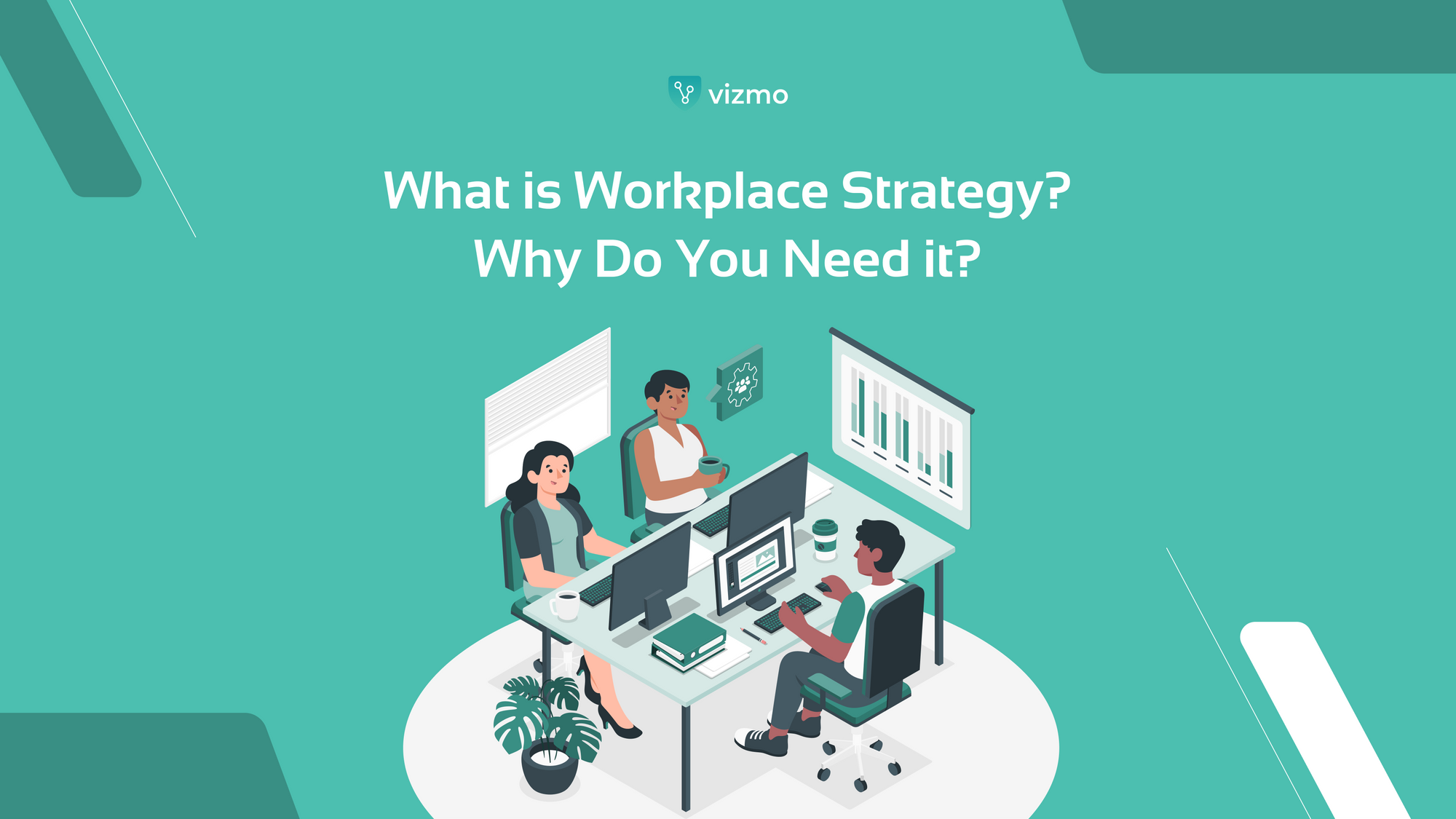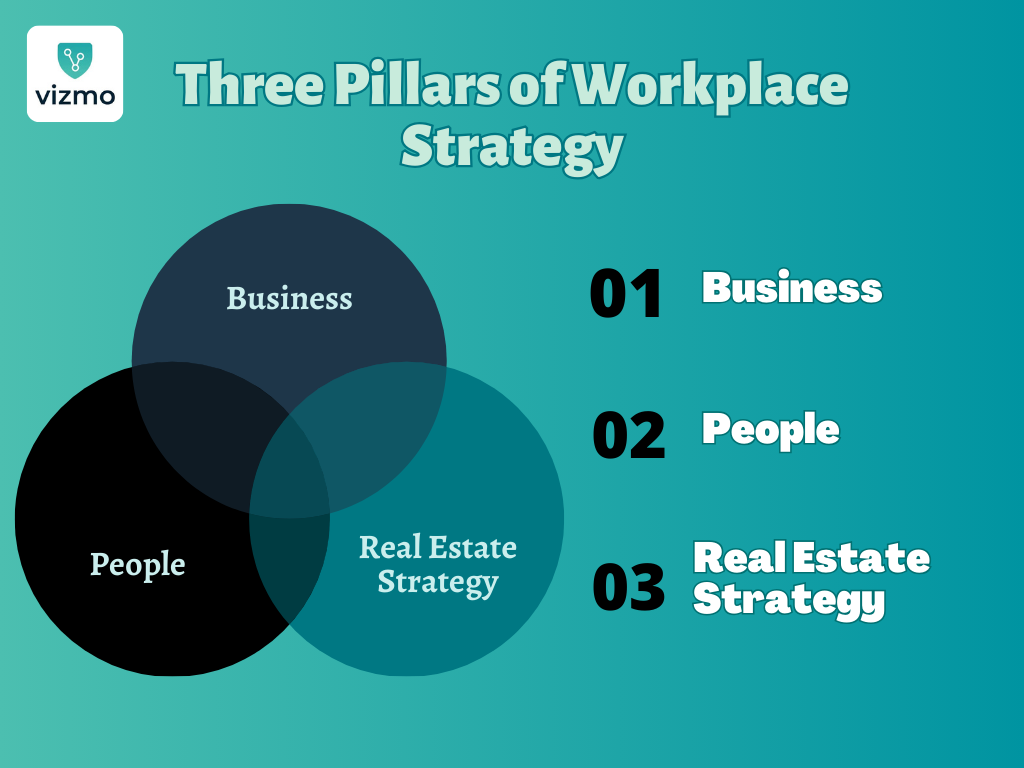What is Workplace Strategy? Why Do You Need it?

In today's business landscape, where the future of work is shifting towards a more liquid workforce that is more mobile, agile, and collaborative, having a well-curated workplace strategy is vital to a healthy organization. But what is a workplace strategy? Let’s understand this buzzword in a more detailed manner.
What Is a Workplace Strategy?
A workplace strategy is an in-depth strategy that aligns an organization's work patterns with its work environment in order to maximize performance while reducing expenses. Organizations design it to optimize their physical workplace while also aligning with their long-term business objectives and the specific needs of their employees. A workplace strategy enables businesses to clearly define their workplace objectives and communicate those expectations to their employees. A thorough workplace plan with a clear direction and goal effectively implements the workplace strategy.
As modern businesses evolve, so does the need for a modern workplace strategy. According to CBRE's APAC Occupier Survey, the drivers of workplace strategy are shifting. Improved collaboration with customers, colleagues, and co-workers (58%) has emerged as the primary reason for implementing workplace strategy, closely followed by cost savings (53%) and increased employee productivity (47%). Space efficiency initiatives (55%) are the most popular strategy for lowering occupancy costs, indicating a shift towards maximizing existing resources rather than relocating to decentralized areas for cost-cutting purposes.
Workplace strategy is more than just office layout or design; it is a continuous process that responds to changing business trends and employee preferences. It entails examining the space utilization and seating arrangements in the workplace, understanding the different work styles and needs of employees, and using technology to improve communication and productivity. Furthermore, workplace strategy focuses on improving the employee experience by providing amenities, cultivating a sense of belonging, and promoting work-life balance. Consider the workplace as a hub where people come together to connect and collaborate. And the ultimate goal is to make employees engaged and satisfied with their workplace experience. This will increase individual productivity while also creating a positive and encouraging workplace environment.
Evolution Of Workplace Strategies
The workplace has evolved from traditional office layouts with small cubicles to today's predominant hybrid work model. A variety of factors have shaped the evolution of the workplace, including technological advancements, demographic shifts, pandemics, changing work dynamics, and cultural changes that affect both the workplace and the workforce. Indeed, the workforce is rapidly changing, necessitating the continuous evolution of workplace strategies over time.
Source:https://www.forbes.com/sites/patriciaduchene/2019/03/12/the-evolving-workplace/?sh=2a7ac42a525e
To cater to such a multigenerational workforce, a broad and all-encompassing strategy is required to meet the diverse set of employee preferences within different identity groups.
This also poses a unique set of challenges for leadership as they constantly redefine and re-evaluate their existing workplace strategies. So, it is up to the organization as a whole to come up with innovative ideas to improve the workplace in accordance with current office management trends.
Let's look at how workplace strategies have evolved throughout history.
1. Traditional Office Layouts
In the early days, cubicles, closed-door offices, and hierarchical structures dominated the workplace.
According to Gensler's workplace survey conducted in 2022, traditional office layouts dominated the workplace landscape until the late twentieth century, with 53% of respondents reporting cubicles in their workplaces.
2. Open Plan office
In the late 20th century, the concept of open-plan offices gained prominence, which is a type of design where individual workspaces are arranged in an open layout within the same floor rather than having private cubicles. The goal behind this concept is to encourage interaction, teamwork, flexibility, and effective collaboration. But one of the downsides of not having a desk divider is the increased level of distractions due to noise, lack of privacy, and decreased productivity.
A study published in the Journal of Environmental Psychology discovered that open plan offices can increase communication between co-workers by up to 70%, emphasizing the importance of open layouts in fostering collaboration.
3. Technology Integration
The introduction of technology altered the way workplaces functioned prior to its arrival; it digitized workspaces, allowing remote work, virtual collaboration, and flexible communication. Organizations began incorporating technology solutions like video conferencing, cloud-based platforms, and mobile devices to support remote and hybrid work models. According to the Global Workplace Analytics, 73% of respondents reported being very successful working from home (68% globally).
4. Flexible and Agile Workspaces
As the workforce grew more diverse and dynamic, businesses recognized the importance of flexible and agile workspaces that could adapt to changing needs and employee preferences. Hot desking, activity-based working, co-working spaces and flexible seating arrangements gained popularity, giving employees the freedom to choose where, when, and how they work.
According to a Steelcase survey of 5,000 workers in 11 countries, 87% will spend time in the office, while 45% prefer to work from home. Home provides dedicated workspaces for 70% of employees, in contrast to open desk setups in the office, where more than half have less privacy. Adapting office spaces to changing needs is crucial for organizations.
According to a Steelcase survey of 5,000 workers in 11 countries, 87% will spend time in the office, while 45% prefer to work from home. Home provides dedicated workspaces for 70% of employees, in contrast to open desk setups in the office, where more than half have less privacy. Adapting office spaces to changing needs is crucial for organizations.
5. Workplaces focusing on Employee Experience
Because of the increasing problem of employee dissatisfaction and disengagement in the workplace, organizations have shifted their focus to improving the employee experience. Workplace strategy has evolved to prioritize employee well-being, engagement, and satisfaction, resulting in initiatives such as wellness programmes, Workplace Ergonomics, and onsite gyms and cafeterias.
According to Deloitte's Global Human Capital Trends report 2019, 79% of executives prioritize employee experience, indicating a shift towards workplace strategies that focus on employee well-being and satisfaction.
6. Hybrid Work Models
Employees' preferences have shifted to a hybrid work model in recent years, owing to advancements in remote work technology. The workplace strategy has evolved to accommodate remote and hybrid work arrangements, emphasizing the importance of adaptable policies, digital infrastructure, and collaboration tools.
According to Future Workforce Report 2021 conducted by Upwork, 41.8% of the American workforce was working remotely as of 2021, reflecting the widespread adoption of hybrid work models in response to the COVID-19 pandemic.
7. Data-Driven Decision-Making
At this stage of development, workplace strategy is heavily data-driven and governed by data and workplace analytics, allowing organizations to make informed decisions about space utilization, resource allocation, and employee engagement.
Sensors, occupancy tracking, and workplace management software provide real-time data on how spaces are used, allowing for optimization and continuous improvement.
According to research conducted by Verdantix, organizations that used workplace analytics saved an average of 8% on facility costs while increasing employee productivity by 2%, highlighting the relevance of data-driven decision-making in workplace strategy.
8. ESG Workplace Strategy
Incorporating Corporate Social Responsibility (CSR) and Environmental, Social, and Governance (ESG) principles, workplace strategy has evolved to include sustainability into its basic values and operations. This involves prioritizing green building certifications, using energy-efficient technologies, and incorporating eco-friendly practices into modern workplace strategy.
For example, a research conducted by the United States Green Building Council discovered that green-certified buildings have 20% lower maintenance costs and 10% greater asset values, illustrating the real benefits of incorporating sustainability into workplace strategies.
The Importance of Having a Defined Workplace Strategy
A well-planned, thorough, and structured workplace strategy is always a positive move for any organization. A defined workplace strategy requires a well-planned and structured approach to workplace management. It comprises optimizing the physical workspace, technology infrastructure, organizational culture, and employee policies in alignment with the business' goals and objectives. It entails evaluating present workplace effectiveness, establishing organizational goals, involving various stakeholders, and implementing initiatives and wellness programmes to improve employee engagement, satisfaction, productivity, and overall business performance. A well-defined workplace plan considers issues such as space utilization, technology integration, employee well-being, and flexibility in order to create a work environment that meets the needs of employees while also contributing to the organization's success.
A well-defined workplace strategy is built on three primary pillars: your people, your business, and your real estate strategy.

Let’s understand what are the benefits of having a well-defined workplace strategy.
1. Alignment with Broader Organizational Goals: Workplace strategy ensures that the physical workspace and its operational processes are in line with the business' overall aims and objectives. According to an IBM Global C-suite study, organizations that connect workplace strategy with business objectives see 28% more revenue growth than those who do not.
2. Improved Employee Satisfaction: A well-defined workplace strategy fosters a supportive and engaging work environment, increasing employee satisfaction and morale. Gallup research reveals that organizations with highly engaged employees outperform their peers by 147% in terms of earnings per share.
3. Increased Productivity: Improving workplace efficiency and employee well-being can boost productivity dramatically. A research published in the Journal of Environmental Psychology discovered that optimized office layouts can boost productivity by up to 70%.
4. Cost Reduction: Effective workplace practices maximize resource utilization, resulting in cost savings and increased profitability. According to the Global Workplace Analytics research, employers can save up to $11,000 per year for each person that works remotely half of the time.
5. Talent Acquisition and Retention: Effective workplace strategies attract and retain top talents, creating a competitive advantage and lowering employee turnover. According to LinkedIn's Workplace Culture report, 86% of job seekers would not apply for or accept a job offer from a firm with a negative reputation for workplace culture, emphasizing the importance of workplace strategy in talent acquisition.
Workplace strategy is crucial for businesses and organizations because it assures individual's alignment with organizational goals, increases employee satisfaction and productivity, lowers costs, and promotes talent attraction and retention. These advantages are reinforced by research and data, emphasizing the need to invest in a clear and distinct workplace strategy.
How to Develop a Workplace Strategy?
For creating an effective workplace strategy, a systematic approach is required to assess current workplace effectiveness, identify areas for improvement, and implement steps to improve the workplace environment. Here's a step-by-step guide for doing it:
Evaluate the Current Workplace Effectiveness
Conduct surveys, interviews, and observations to gather employee feedback on workplace experience and obstacles. Distribute anonymous surveys to employees to assess their satisfaction with the current workspace, including layout, amenities, and technology. And address such issues in weekly town hall discussions.
According to a survey conducted by Harvard Business Review Analytic Services, 58% of employees believe their office environment has a direct impact on their productivity and job satisfaction.
- Analyze different Metrics and Identify needs:
Analyze the obtained data to identify workplace trends, pain points, and areas for improvement. For instance, analyze survey data to find common themes, such as the need for more collaboration spaces or better technology infrastructure. - Set Clear Objectives and Goals: Set specific objectives and targets for the workplace strategy based on the identified needs and priorities. Set goals such as promoting employee collaboration, increasing production, and lowering real estate expenditures.
According to the Society for Human Resource Management (SHRM), organizations with a well-defined workplace strategy are 3.5 times more likely to succeed in meeting their business goals. - Develop Action Plan: Develop a clear action plan that includes specific actions, deadlines, and responsibilities for achieving the set goals.
Implement measures such as redesigning office layouts to encourage collaboration, improving technology infrastructure, or implementing flexible work practices. - Execution of Planned Actions: Execute actions as specified in the action plan, with excellent communication and stakeholder participation throughout.
For example, work with facilities management and IT teams to implement workplace redesigns and technological upgrades, while keeping staff informed on a regular basis. - Monitor and Evaluate Progress: Continuously monitor and evaluate the progress of the workplace strategy implementation, gathering feedback and making adjustments as necessary.
For example, conduct follow-up surveys and focus groups to assess the impact of implemented initiatives on employee satisfaction and productivity.
Benefits of Following The Aforementioned Steps
Organizations can benefit from implementing these steps in the following ways:
1. It would aid in gaining important insights into employee wants and preferences, helping organizations to make better decisions and provide targeted workplace solutions.
2. It would help to integrate workplace strategy with organizational goals and priorities, ensuring that resources are allocated effectively to achieve the intended outcomes.
3.It would help to improve employee satisfaction, engagement, and productivity by establishing a work environment that is tailored to their requirements and develops a sense of belonging.
4.It would make it easier to optimize resource utilization and cut costs by integrating technology, streamlining procedures, and managing space more efficiently.
5. It would enable the creation of a workplace environment that promotes business profitability and a positive culture, thus encouraging creativity, collaboration, and long-term growth.
After going through the specifics of workplace strategy development, it’s evident that crafting a well-defined workplace strategy is imperative for organizations to succeed. It entails matching work patterns with the work environment in order to improve performance and reduce costs. Workplace strategy responds to changing business trends and employee preferences, with an emphasis on improving the work experience and achieving organizational goals. Businesses can support productivity, engagement, and creativity in the workplace by studying its evolution over time and understanding its main components.
Are you ready to implement your workplace strategy effectively? Check out our customized solutions for visitor and workplace management today.
FAQ’s
Why Is Workplace Strategy Important?
Workplace strategy is important since it is not only about where we work but also how we work. It sets the tone for our everyday interactions, influencing productivity, enjoyment, and overall well-being. A carefully planned workplace strategy fosters an environment in which we feel respected, encouraged, and empowered to accomplish our best work. It's about building relationships, driving innovation, and, eventually, creating a culture in which both individuals and organizations may thrive.
How Remote and Hybrid Work Impact Your Workplace Strategy? Remote and hybrid work have transformed workplace strategy by questioning conventional ideas about where and how work is done. These new models have prompted organizations to reconsider their strategy, emphasizing flexibility, technological integration, and employee well-being. It is about building environments that encourage collaboration regardless of physical location, and ensuring that employees have the tools and resources they require to succeed, whether they are in the office or working remotely. Finally, it is about accepting change, adapting to new methods of working, and developing a workplace plan that addresses the changing demands of both individuals and teams.
Is There an Optimal Approach to Workplace Strategy?
There is no one-size-fits-all solution for workplace strategy. It is important to strike the correct balance for your organization, taking into account aspects such as company culture, industry trends, and employee preferences. It is an ongoing process of continuous learning and modification, with experimentation and feedback playing an important role in defining the best strategy. Finally, it's about building a workplace environment that reflects your values, supports your goals, and enables your employees to succeed.

